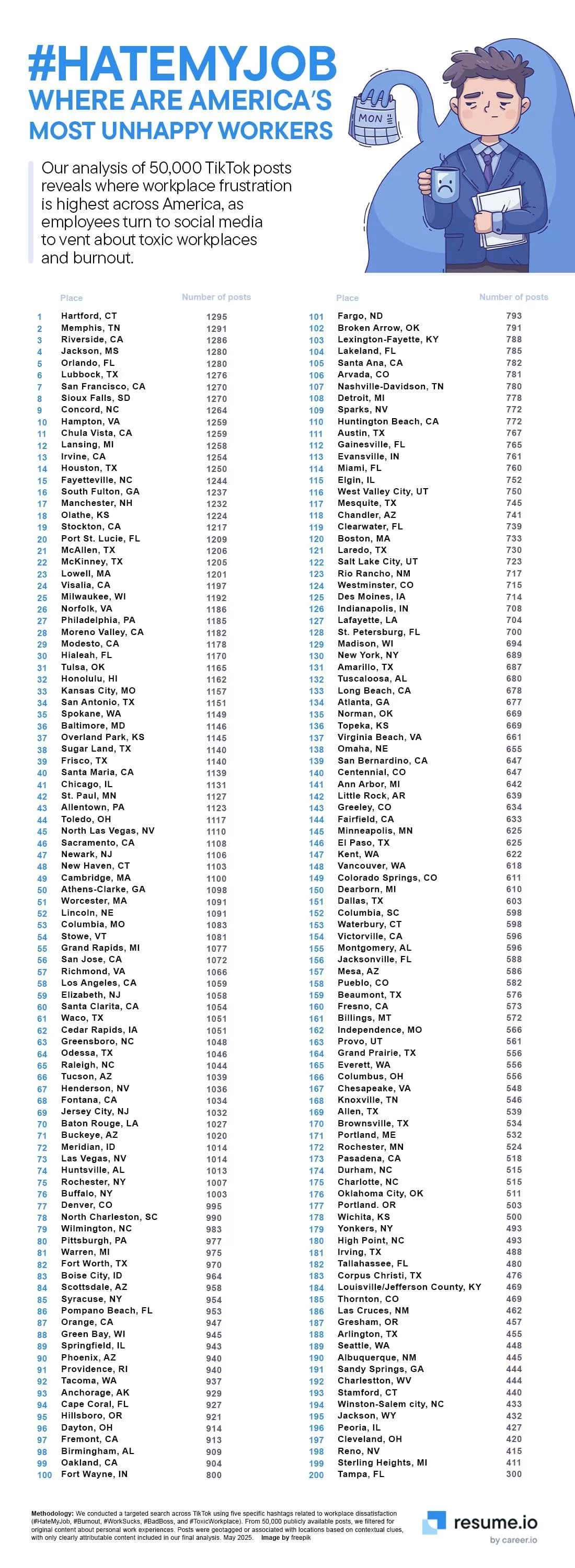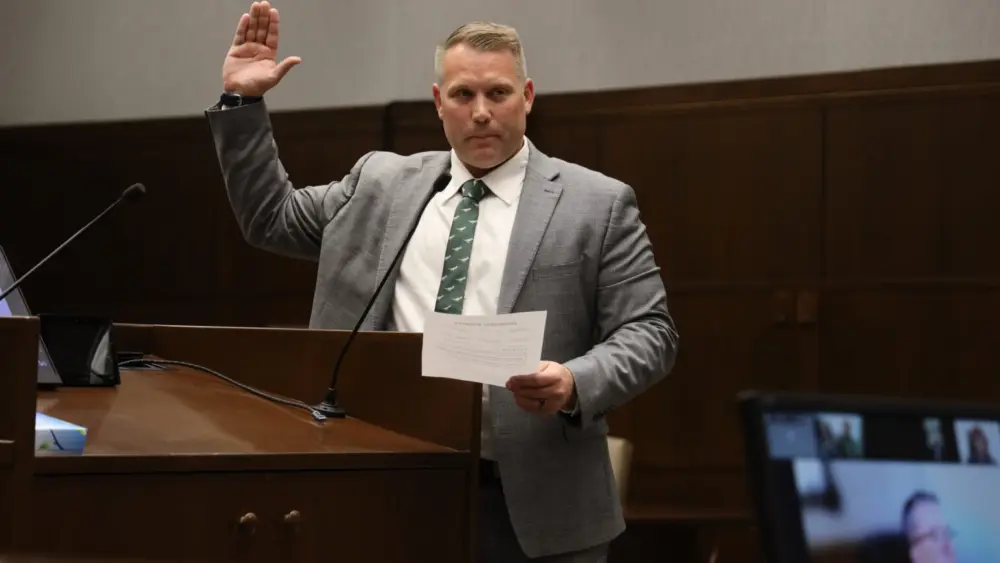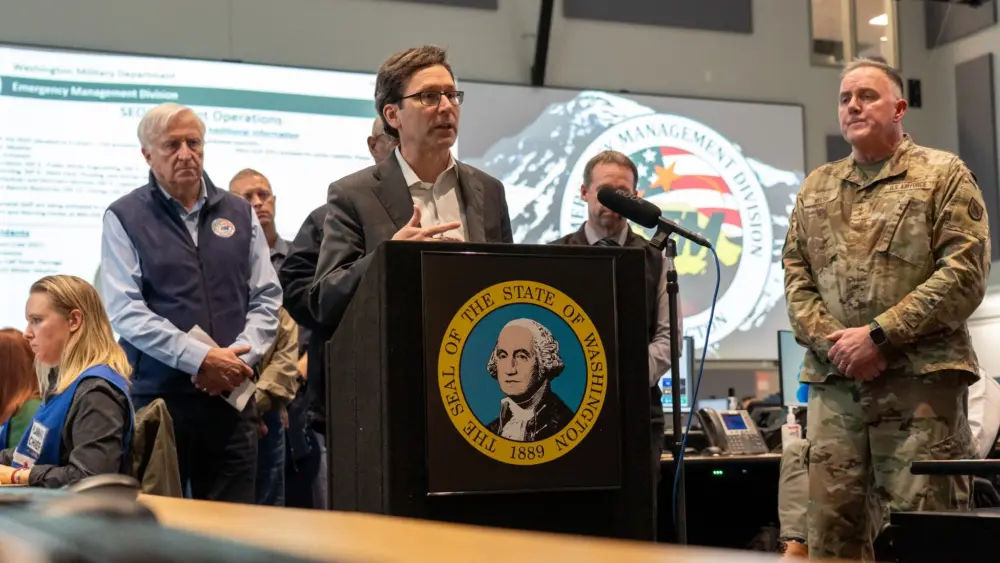NATIONAL – Social media has become a major outlet for people to vent about their jobs, and TikTok is no exception. Hashtags like #WhyAmIHere, #MondayMisery, and #NotLivingTheDream might sound like jokes, but they often hide real frustration with work.
A recent study by resume.io analyzed 50,000 TikTok posts to find out which cities in America have the most unhappy workers. By focusing on five hashtags, #HateMyJob, #Burnout, #WorkSucks, #BadBoss, and #ToxicWorkplace, the study has given us a glimpse into where workplace dissatisfaction is running high.
What the Hashtags Tell Us
#HateMyJob
This one is pretty self-explanatory – it’s about feeling frustrated with work. Posts using this hashtag often describe how people are stuck in boring, repetitive jobs or feel like their work has no real purpose.
#Burnout
Burnout is a big one. It’s not just feeling tired; it’s that deep exhaustion that comes from constant work stress. TikTok users are quick to share how long hours, constant pressure, and a lack of work-life balance are taking their toll.
#WorkSucks
Short and sweet, #WorkSucks sums up all the little annoyances that can make a job feel unbearable, such as unproductive meetings, broken equipment, or frustrating coworkers.
#BadBoss
We’ve all had that boss. This hashtag is about the negative impact of bad management, whether it’s micromanaging, a lack of support, or poor leadership.
#ToxicWorkplace
This one flags deeper, more serious issues in the workplace, like hostile environments or unfair treatment. Posts under this hashtag often describe a toxic workplace culture — think favoritism, cliques, or general negativity.
The Top 10 Cities for Workplace Complaints (based on hashtags – per 50,000 posts):
#1. Hartford, CT (1,295 posts) – A city with many corporate and insurance jobs that can feel limiting for some.
#2. Memphis, TN (1,291 posts) – Jobs in logistics and healthcare often come with demanding hours and stress.
#3. Riverside, CA (1,286 posts) – A lot of warehouse and retail work, which can feel repetitive with little room for growth.
#4. Jackson, MS (1,280 posts) – Limited job options leave workers feeling stuck and frustrated.
#5. Orlando, FL (1,280 posts) – Hospitality and tourism jobs are often low-paying and come with high stress.
#6. Lubbock, TX (1,276 posts) – A smaller city with limited job variety, mostly in agriculture and education.
#7. San Francisco, CA (1,270 posts) – A fast-paced tech industry that can foster high-pressure and toxic work environments.
#8. Sioux Falls, SD (1,270 posts) – Rapid growth in finance might be causing workplace tension.
#9. Concord, NC (1,264 posts) – Manufacturing and retail jobs, where advancement is often limited.
#10. Hampton, VA (1,259 posts) – Military and government jobs can feel rigid and bureaucratic.
When it comes to Idaho, the most unhappy employees can be found in the following cities (with national rankings):
#72. Meridian (1,014 posts) – Picture-perfect suburbs, but behind the picket fence, workers are asking: “Is this really it?”
#83. Boise City (964 posts) – Rapid growth, rising stress. What used to be chill now feels like a race with no finish line.
To visualize the findings, resume.io created an infographic ranking the U.S. cities with the most unhappy workers:
Why Are Workers So Unhappy?
Several factors seem to be driving workers’ discontent. In cities with a high cost of living, demanding jobs create significant stress. In smaller cities, fewer job opportunities can make workers feel stuck. In industries like hospitality, long hours and low pay add to the frustration. On top of that, poor management or toxic workplace cultures can make matters even worse.
But there’s a bright side: by sharing their experiences on TikTok, workers connected with others who feel the same way, sparking important conversations about workplace issues.
Amanda Augustine of resume.io says: “Social media has become a powerful outlet for workers to voice frustrations they might not feel safe sharing at work – and now they’re doing it in a very public way.. These hashtags aren’t just complaints; they’re a wake-up call for employers to start listening and take real steps to fix what’s broken.”
Looking Ahead
For employers, this is an opportunity to listen and take action. Improving communication, offering greater flexibility, and addressing toxic workplace cultures can make a meaningful difference. For workers, these hashtags serve as a reminder that they’re not alone – and that change may be possible when voices come together.






